ST Microelectronics S R L BNRGM2SA BLUENRG-M2SA Bluetooth Low Energy Module User Manual BlueNRG M2SA Datasheet IMQ DRAFT 2018 10 19
ST Microelectronics S.R.L. BLUENRG-M2SA Bluetooth Low Energy Module BlueNRG M2SA Datasheet IMQ DRAFT 2018 10 19
Users manual
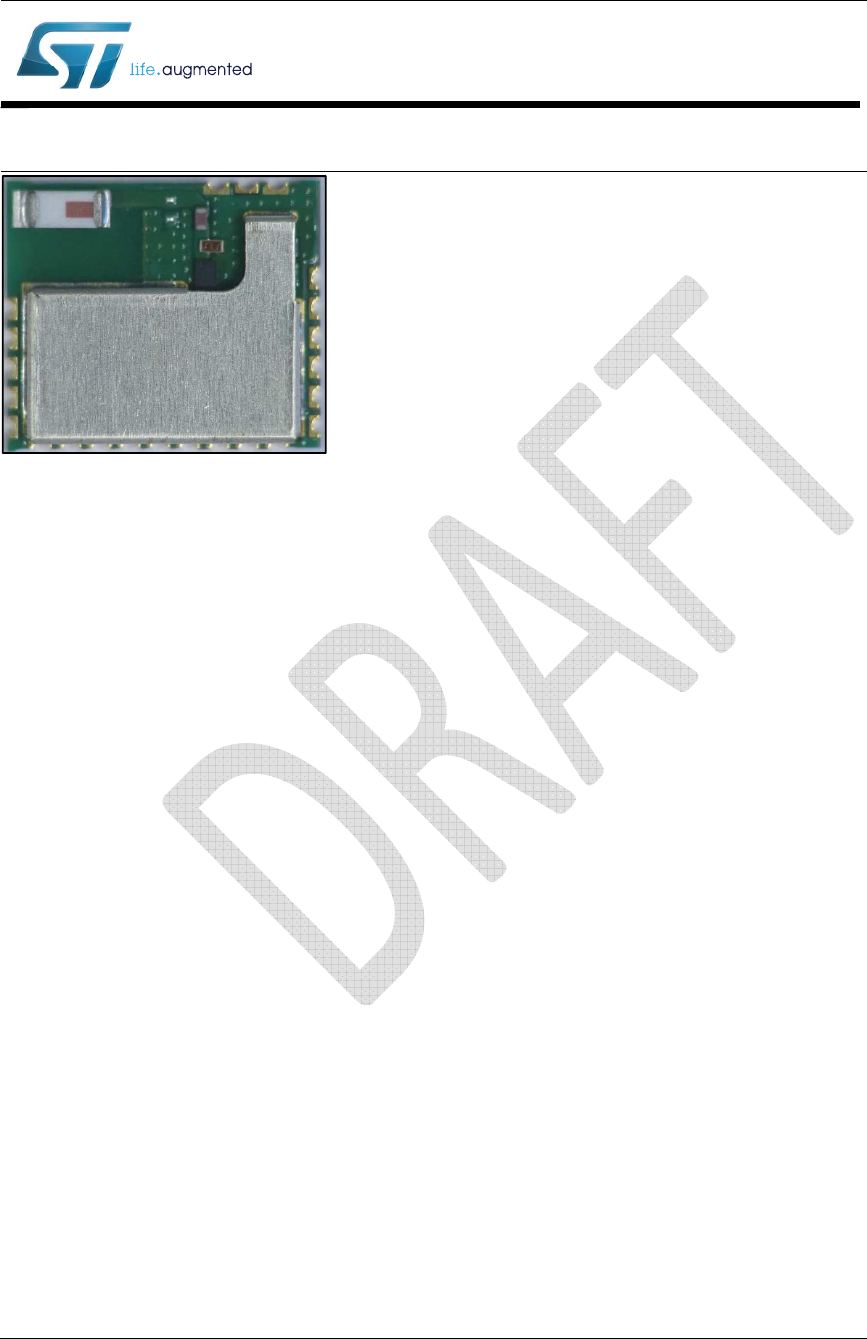
Very low power BlueNRG module for Bluetooth® Low Energy v5.0
• Bluetooth v5.0 compliant
– Supports master and slave modes
– Multiple roles supported simultaneously
• Based on BlueNRG-2, BLE SoC:
– High performance, ultra-low power Cortex-
M0 32-bit based core
– Programmable embedded 256 KB Flash
– 24 KB embedded RAM with data retention
• Interfaces:
1 x UART, 1 x I2C, 1xSPI, 14 x GPIO, 2
x multifunction timer, 10-bit ADC,
Watchdog & RTC, DMA controller, PDM
stream processor, SWD debug Interface
• Bluetooth radio performance:
– Max Tx power: + 8 dBm
– Excellent link reliability
– Embedding BALF-NRG-02D3 integrated
matched balun with harmonic filter
• On-board chip antenna
• Small form factor: 11.5mmx13.5mm
• Complemented with Bluetooth low energy
protocol stack library (GAP, GATT, SM,
L2CAP, LL)
• AES security co-processor
• Bluetooth low energy SDK with wide range of
profile available
• Certifications:
– EU (RED) Type certificate
– FCC, IC modular approval certification
– BT SIG End Product QDID
• Pre-programmed UART bootloader
• Operating supply voltage: from 1.7 to 3.6 V
• Operating temperature range: -40 °C to 85 °C
Applications
• Internet of Things
• Smart Home
• Building and Industrial Automation
• Smart Lighting
• Remote and access control
• Fitness, wellness and sports
• Consumer medical
• Security and proximity
• Assisted living
• PC and smart phone peripherals
Description
The BLUENRG-M2SA is a Bluetooth
®
low
Energy System-on-Chip application processor
certified module, compliant with BT specifications
v5.0 and BQE qualified. The BLUENRG-M2SA
module supports multiple roles simultaneously
and can act at the same time as Bluetooth Smart
master and slave device.
The BLUENRG-M2SA is based on BlueNRG-2
system-on-chip and entire Bluetooth Low Energy
stack and protocols are embedded into module.
The BLUENRG-M2SA module provides a
complete RF platform in a tiny form factor. Radio,
embedded antenna and high frequency
oscillators are integrated to offer a certified
solution to optimize the time to market of the final
applications.
The BLUENRG-M2SA can be powered directly
with a pair of AAA batteries or any power source
from 1.7 to 3.6 V.
BlueNRG-M2SA
Preliminary Datasheet
Features

BlueNRG-M2SA
Rev 0.1 P a g e | 2
32
Contents
1
General description ................................................................................... 4
2
Block diagram ............................................................................................ 5
3
Software Development .............................................................................. 6
3.1 Software development Kit ............................................................................. 6
3.2 Software Architecture ................................................................................... 7
4
Hardware specifications ........................................................................... 8
4.1 Absolute maximum ratings ........................................................................... 8
4.2 Recommended operating conditions ............................................................ 8
4.3 Radio Features ............................................................................................. 8
4.4 Current consumption .................................................................................... 9
Reported values have been taken configuring the tool as shown in the Figure 4. ... 9
4.5 Pin assignment ........................................................................................... 11
4.6 Mechanical dimensions .............................................................................. 13
5
Hardware design ......................................................................................14
5.1 Reset Circuitry ............................................................................................ 14
5.2 Debug Interface .......................................................................................... 14
5.3 Reflow soldering ......................................................................................... 15
6
Regulatory compliance ............................................................................17
6.1 FCC certification ......................................................................................... 17
6.1.1
Labeling instructions .............................................................................................. 17
6.1.2
Product manual instructions .................................................................................. 18
6.2 IC certification ............................................................................................ 19
6.2.1
Labeling instructions .............................................................................................. 19
6.2.2
Product manual instructions .................................................................................. 20
6.3 EU Type approval for BLUENRG-M2SA module ........................................ 21
6.4 Bluetooth certification ................................................................................. 21
7
Ordering information ................................................................................29

BlueNRG-M2SA
Rev 0.1 P a g e | 3
32
8
ECOPACK
®
................................................................................................30
9
Traceability ...............................................................................................30
10
Revision history .......................................................................................31

BlueNRG-M2SA
P a g e | 4
Rev. 0.1
1 General description
The BLUENRG-M2SA is a Bluetooth Smart application processor module compliant with
Bluetooth
®
specifications v5.0 with embedded ceramic antenna.
The BLUENRG-M2SA module has been designed around the ST BlueNRG-2 SoC where
its Cortex-M0 core can execute both Bluetooth protocols and customer application. A
complete power-optimized Bluetooth stack library provides:
• Master, slave, multiple roles support
• GAP: central, peripheral, observer or broadcaster roles
• simultaneous advertising and scanning
• capability of being slave of up to two masters simultaneously
• ATT/GATT: client and server
• SM: privacy, authentication and authorization
• L2CAP
• Link Layer: AES-128 encryption and decryption
The BLUENRG-M2SA has 160KB embedded Flash and 24KB embedded RAM memory.
In the module are available 32MHz and 32KHz crystal oscillators. It has been designed to
leverage the BlueNRG-2 integrated DC-DC step down converter in order to achieve best
power consumption in active mode.
It can be configured to support both application processor (host-less) and network
processor (hosted) modes.
Being based on the BlueNRG-2 SoC, the BLUENRG-M2SA module leverages all the tools
and documentation of its ecosystem: Development Kit, Application Notes, User Manuals,
Design Notes & Tips. A wide set of sample programs are also available in C source code.
The BLUENRG-M2SA module has a wide set of peripherals available for customer
application (1 x UART interface, 1 x SPI interface, 1 x I
2
C interface, 14 GPIO, 2 x
multifunction timer, 10-bit ADC, Watchdog & RTC, DMA controller, PDM stream processor).
The BLUENRG-M2SA module enables wireless connectivity into electronic devices, not
requiring any RF experience or expertise for integration into the final product. The
BLUENRG-M2SA module provides a complete RF application platform in a tiny form factor
(11.5 x 13.5 x 2.0 mm) and being a certified solution optimizes the time to market of the
final applications.
The BLUENRG-M2SA module allows applications to meet the tight advisable peak current
requirements imposed with the use of standard coin cell batteries. Optimized results are
obtained with the embedded high-efficiency DC-DC step-down. BLUENRG-M2SA can be
powered directly with a standard 3 V coin cell battery as with a pair of AAA batteries or any
power source from 1.7 to 3.6 V.
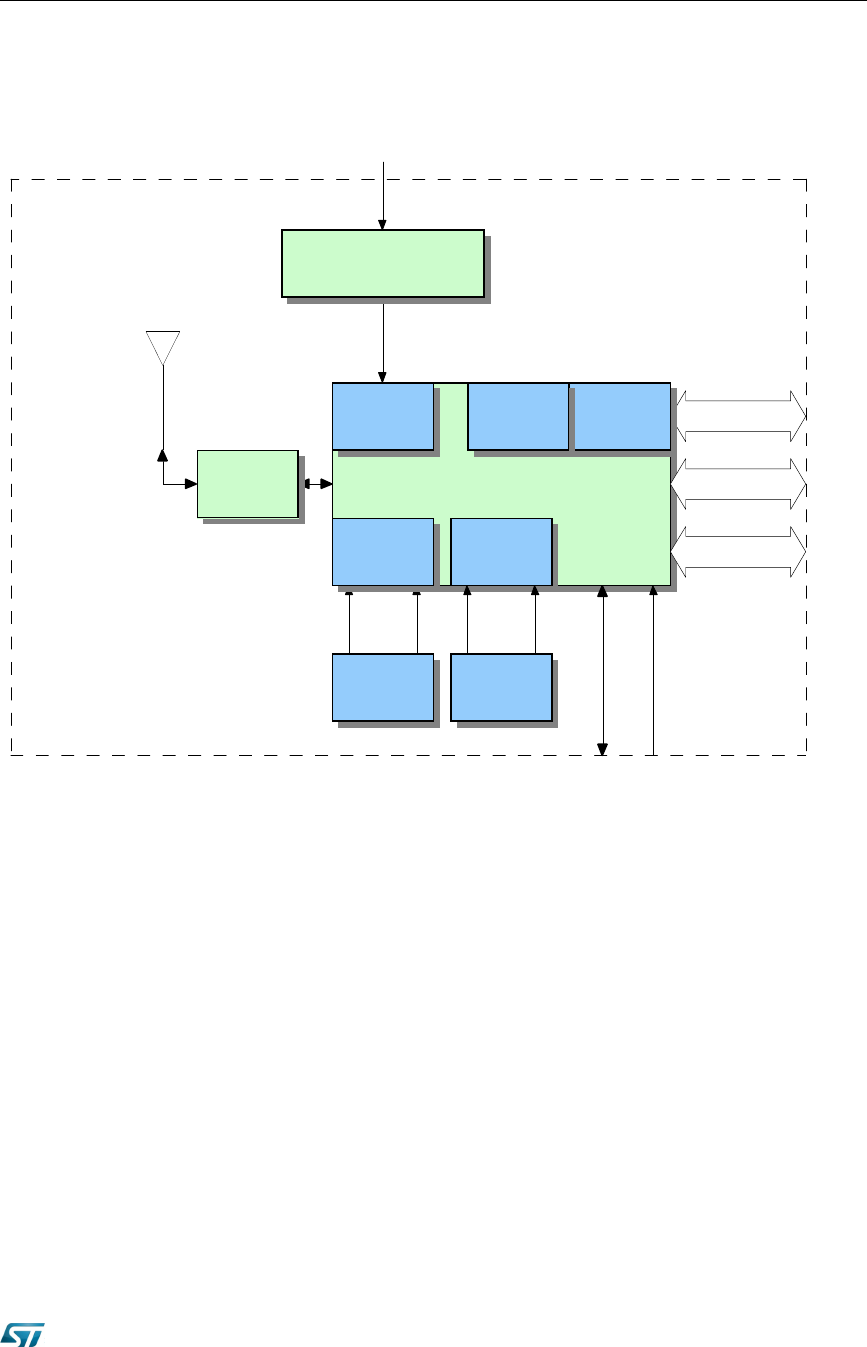
BlueNRG-M2SA
Rev 0.1 P a g e | 5
32
2 Block diagram
CERAMIC ANTENNA
Battery or External Supply
Host Controller
interface
Crystal
32 MHz
clock
RF
BALUN
+ Filter
INTERNAL 2.45 GHz Bluetooth
I/0
Signals
(Optionals)
BLUETOOTH
BLUENRG-2
32 MHz
internal
clock
32.768 kHz
internal
clock
I2CBUS LINE
I
SPI LINE
UART LINE
ADC (2 ch. max)
GPIO signals
RAM
MEMORY
(24 kB)
BLUENRG-M2SA
INTERNAL
regulator
FLASH
MEMORY
(256 kB)
SIMPLE SUPPLY FILTER
(Only Capacitors)
Crystal
32.768 kHz
clock
Figure 1: HW block diagram

BlueNRG-M2SA
P a g e | 6
Rev. 0.1
3 Software Development
3.1 Software development Kit
The BLUENRG-M2SA module embeds the BlueNRG-2 application processor. Refer to the BlueNRG-2
web page (http://www.st.com/en/wireless-connectivity/BlueNRG-2.html) to get access to:
• BlueNRG-2 datasheet
• development kit
• application notes
• user manuals
• tools & software
• design note and tips
Software and firmware should be configured taking into account the BLUENRG-M2SA specific
configuration as described in the block diagram chapter. In particular the BLUENRG-M2SA module has:
• 32 MHz crystal oscillator
• 32 KHz crystal oscillator
• SMPS DC-DC converter
• 10
µ
H SMPS inductor
The projects provided with the development kit should be customized defining as following:
• HS_SPEED_XTAL=HS_SPEED_XTAL_32MHZ
• LS_SOURCE=LS_SOURCE_EXTERNAL_32KHZ
• SMPS_INDUCTOR=SMPS_INDUCTOR_10uH
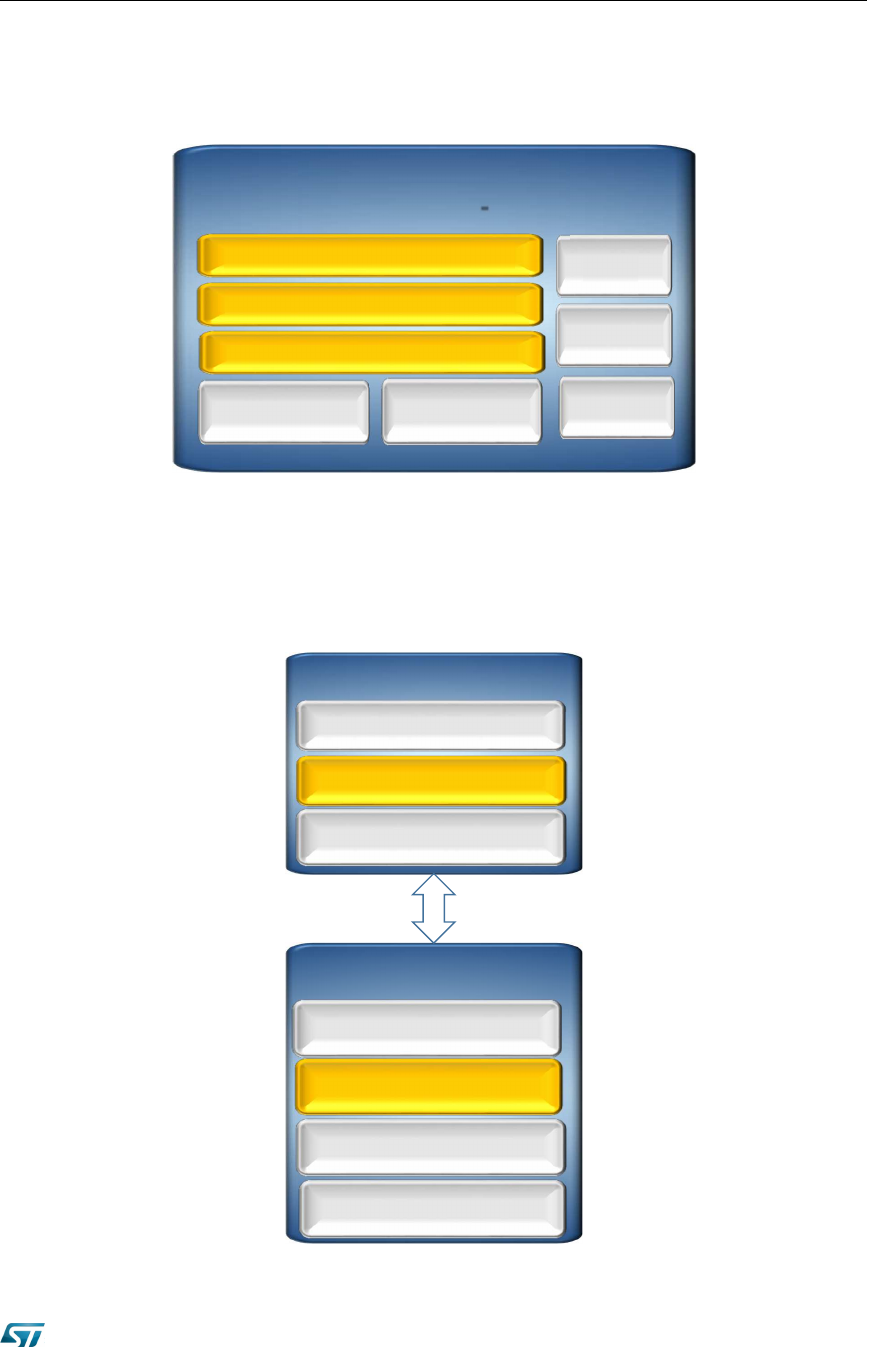
BlueNRG-M2SA
Rev 0.1 P a g e | 7
32
3.2 Software Architecture
There are two possible software architectures:
1. Host-less mode (application processor): customer application runs on the BLUENRG-M2SA
module. Many sample projects are available in the Development Kit.
Figure 2: BLUENRG-M2SA - BLE Application Processor
2. Hosted mode (Network processor): the module is configured as network module controlled by
an external host connected via SPI or UART. A project named DTM is available in the
Development Kit that configures the BLUENRG-M2SA module as a network module.
Figure 3:BLUENRG-M2SA as BLE Network Processor
2
.4
GHz
BlueNRG Radio
Link Layer
GPIO
Cortex
-
M
0
32MHz
BLE Application Processor
BlueNRG-M2SA
Comm.
Peripherals
BLE Protocol stack
Application and Profiles
ADC
BLE Profiles
Application
External MCU
BLE
P
r
otocol stack
2
.4
GHz BlueNRG
R
a
dio
Link
La
y
er
BLE Network Processor
Application Controller
Interface
Application Controller
Interface
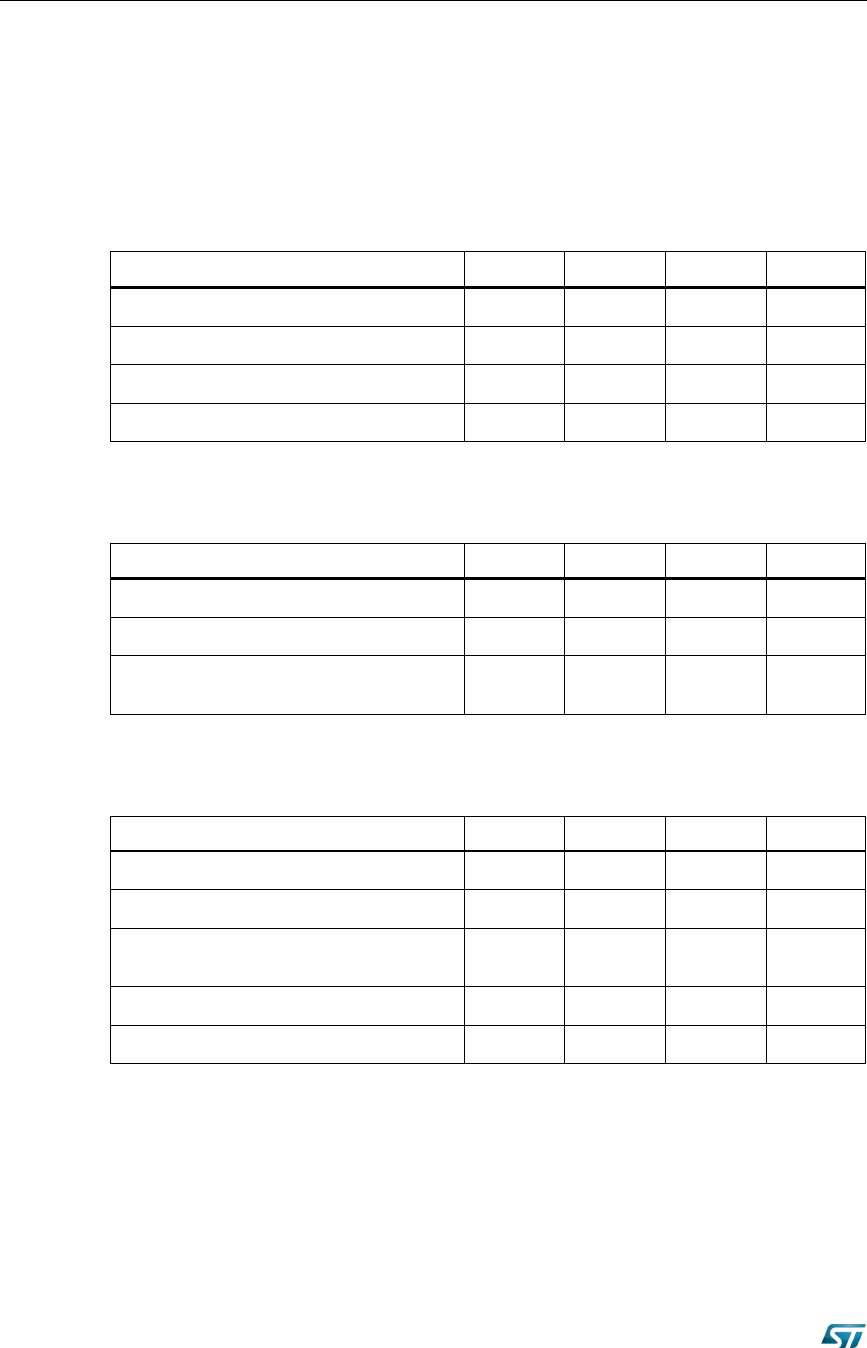
BlueNRG-M2SA
P a g e | 8
Rev. 0.1
4 Hardware specifications
General conditions (V
IN
= 3.3 V and 25 °C)
4.1 Absolute maximum ratings
Rating
Min
Typ.
Max
Unit
Storage temperature range
-40
-
+85
°C
Supply voltage, V
IN
-0.3
-
3.9
V
I/O pin Voltage (V
IO
five-volt tolerant pin)
-0.3
-
3.9
V
RF saturation input power
-
8
-
dBm
Table 1: Absolute maximum ratings
4.2 Recommended operating conditions
Rating
Min
Typ.
Max
Unit
Storage temperature range
-40
-
+85
°C
Supply voltage, V
IN
1.7
3.3
3.6
V
Signals & I/O pin voltage
(according supply voltage)
1.7
-
3.6
V
Table 2: Recommended operating conditions
4.3 Radio Features
Rating
Min
Typ.
Max
Unit
Bluetooth version - 5.0 -
Radiated transmit power +8 dBm
Receiver sensitivity -88 dBm
RF Frequency 2402 - 2480 MHz
HS_Startup_Time (*) 512 µs
Table 3: Radio features
(*) The HS_Startup_Time has been measured according to the “Bringing up the BlueNRG-2 device”
(AN4818). The HS_Startup_Time parameter is important because it permits minimization of the
current consumption. A value that is too short prevents the BLUENRG-M2SA from correctly
sending/receiving packets. Users should set the typical value as indicated in Table 3.
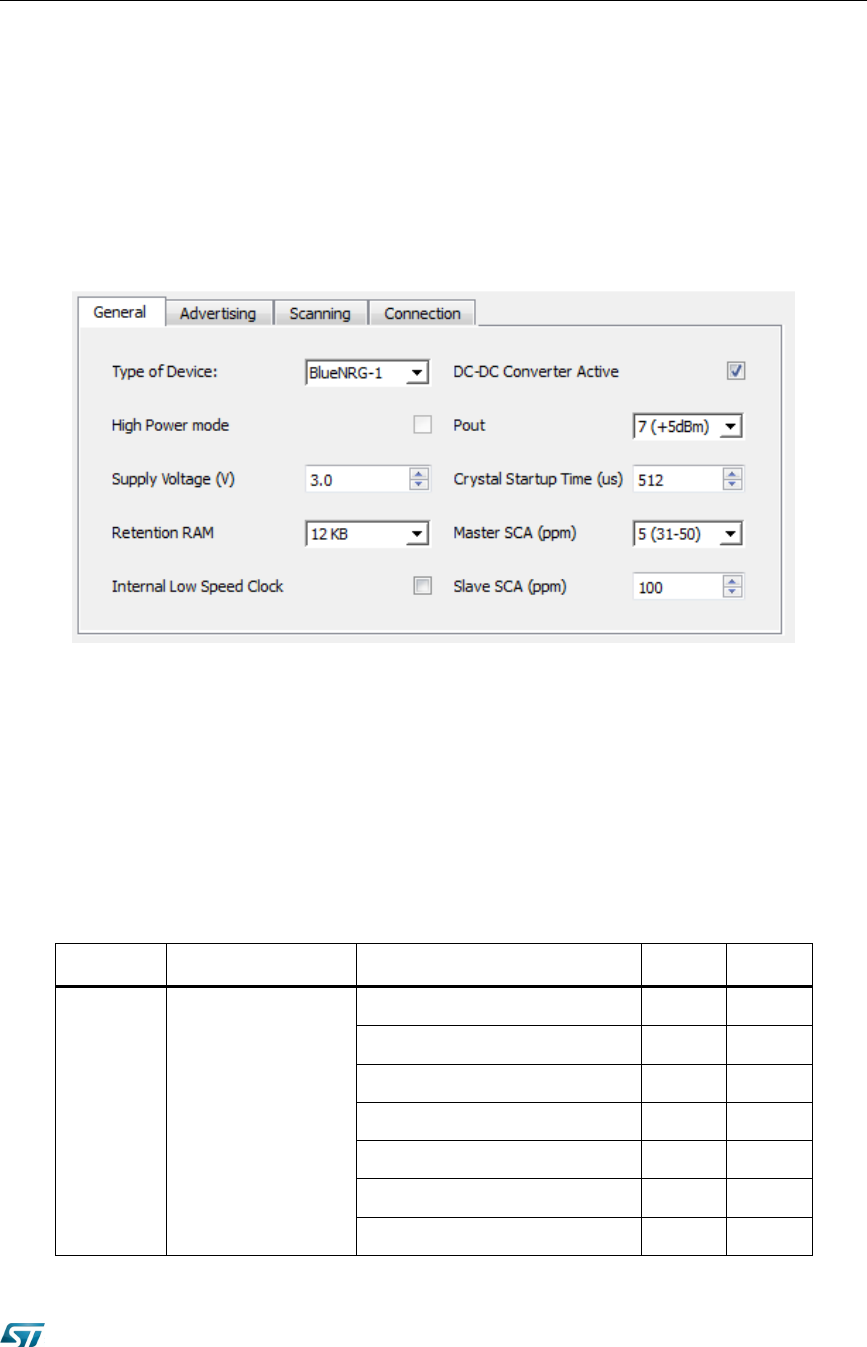
BlueNRG-M2SA
Rev 0.1 P a g e | 9
32
4.4 Current consumption
Characteristics measured over recommended operating conditions unless otherwise
specified. Typical value are referred to T
A
= 25 °C, V
in
= 3.0 V
Current consumption values has been taken using the “BlueNRG current consumption estimation tool”,
configured to match the BLUENRG-M2SA configuration.
The tool is available on ST.com at: http://www.st.com/en/embedded-software/stsw-bnrg001.html
Reported values have been taken configuring the tool as shown in the Figure 4.
Figure 4: Configuration of the “BlueNRG Current Consumption Estimation Tool”
Symbol
Parameter
Test conditions
Typ.
Unit
IDD
Supply current
Reset
5
nA
Standby
500
nA
Sleep mode
0.9
µA
Active Mode
1.9
mA
RX
7.7
mA
TX: +8 dBm (programmed)
17
mA
TX: 0 dBm 11 mA
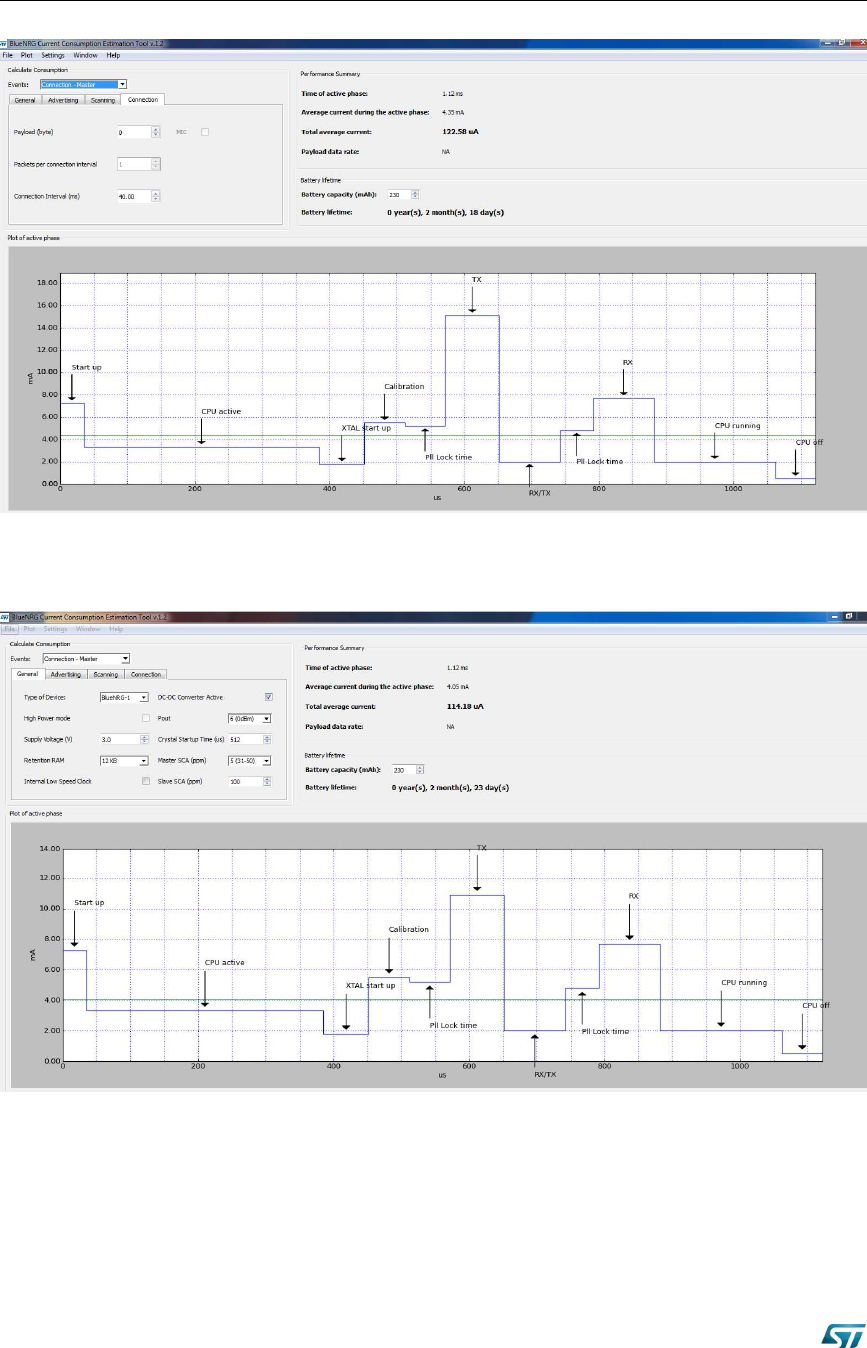
BlueNRG-M2SA
P a g e | 10 Rev. 0.1
Figure 5: Typical current consumption profile at +5dBm
Figure 6: Typical current consumption profile at 0 dBm
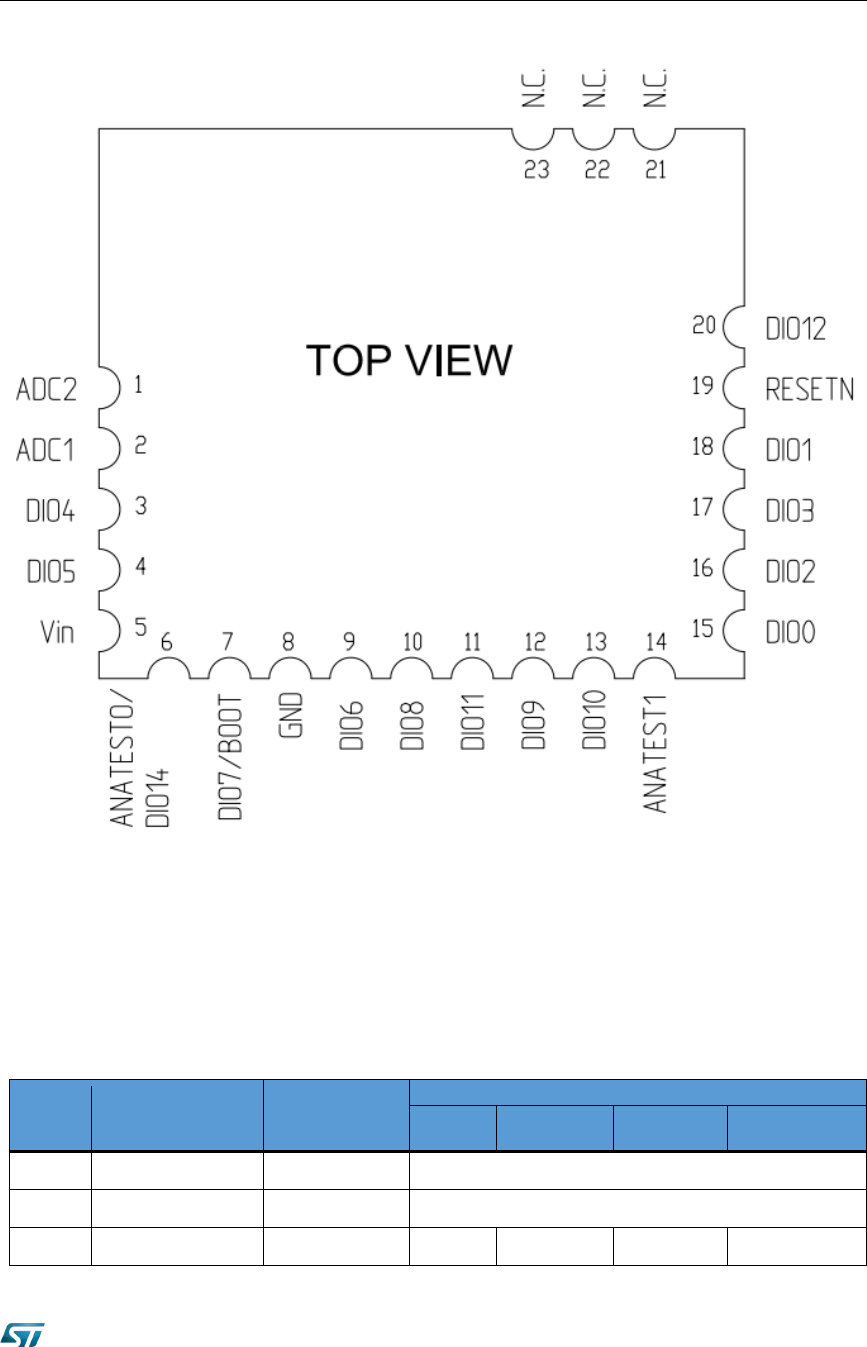
BlueNRG-M2SA
Rev 0.1 P a g e | 11 32
4.5 Pin assignment
Figure 7: Pin assignment
As described in the previous picture the BLUENRG-M2SA module is using exposed pad in order to allow
a full optical visual inspection in order to fulfill the needs of industrial grade applications.
The Table 4 provides the association between BLUENRG-M2SA module pin and the related BlueNRG-2
pin. Refer to the BlueNRG-2 datasheet for detailed description.
Module
Pin # Module Pin Name
BlueNRG-2 Function
Pin
(CSP package) Mode:
“000” Mode: “001”
Mode:
“100” Mode: “010”
1 ADC2 D5 ADC input 2
2 ADC1 B4 ADC input 1
3 DIO4 C3 GPIO4 UART_RXD
I2C2_CLK PWM0
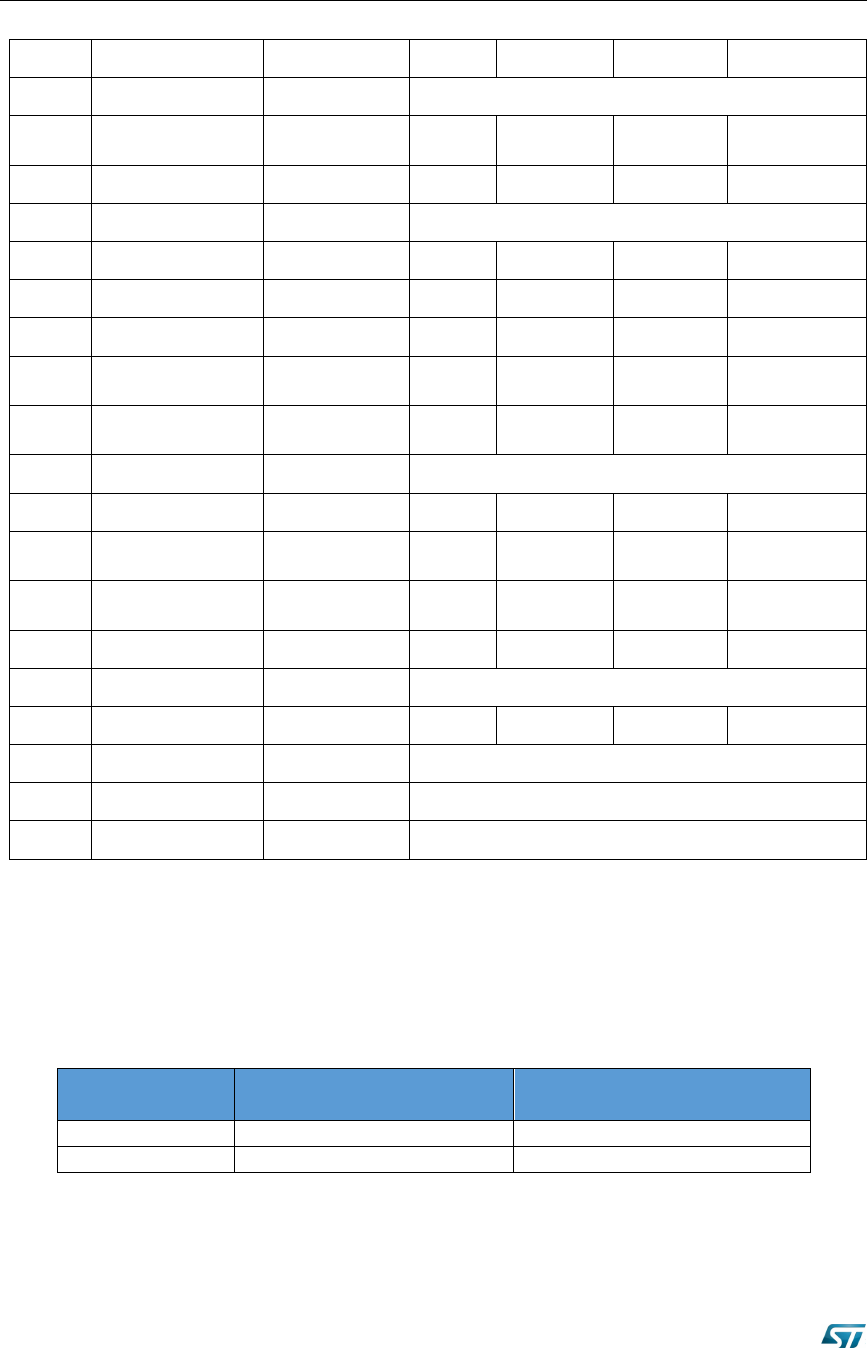
BlueNRG-M2SA
P a g e | 12 Rev. 0.1
4 DIO5 C2 GPIO5 UART_TXD
I2C2_DAT PWM1
5
Vin A3, E6 Supply pin
6 ANATEST0/
DIO14/ A5 GPIO14 I2C1_CLK SPI_CLK ADC_DATA
7 DIO7/BOOT(*) D2 GPIO7 UART_CTS
I2C2_DAT PDM_CLK
8 GND A4, B6, C1, F5 Ground
9
DIO6 D1 GPIO6 UART_RTS
I2C2_CLK PDM_DATA
10 DIO8 D3 GPIO8 UART_TXD
SPI_CLK PDM_DATA
11 DIO11 E2 GPIO11 UART_RXD
SPI_CS1 -
12 DIO9 E1 GPIO9 SWCLK SPI_IN
(***)
13 DIO10 F1 GPIO10 SWDIO SPI_OUT
(**)
14 ANATEST1 D4 Anatest1
15 DIO0 A2 GPIO0 UART_CTS
SPI_CLK -
16 DIO2 A1 GPIO2 PWM0 SPI_OUT
(**) PDM_CLK
17 DIO3 B1 GPIO3 PWM1 SPI_IN
(***) ADC_CLK
18
DIO1 B2 GPIO1 UART_RTS
SPI_CS1 PDM_DATA
19
RESETN B3 Reset Pin
20 DIO12 F2 GPIO12 - I2C1CLK
21
N.C N/A Must be left floating
22 N.C N/A Must be left floating
23 N.C N/A Must be left floating
Table 4: Pinout description
(*) The pin DIO7/BOOT is monitored by bootloader after power up or hardware Reset and it should be low to
prevent unwanted bootloader activation
(**) The function SPI_OUT indicates that the pin is always an output when configured for SPI. Thus in case of SPI
master role, it acts as MOSI pin. In case of SPI slave role, this pin act as MISO. See Table 5.
(***)The function SPI_IN indicates that the pin is always an input when configured for SPI. Thus in case of SPI master
role, it acts as MISO pin. In case of SPI slave role, this pin act as MOSI. See Table 5.
SPI function BLUENRG-M2SA SPI Role =
Master
BLUENRG-M2SA SPI Role =
Slave
SPI_IN SPI MISO SPI MOSI
SPI_OUT SPI MOSI SPI MISO
Table 5: SPI pin function
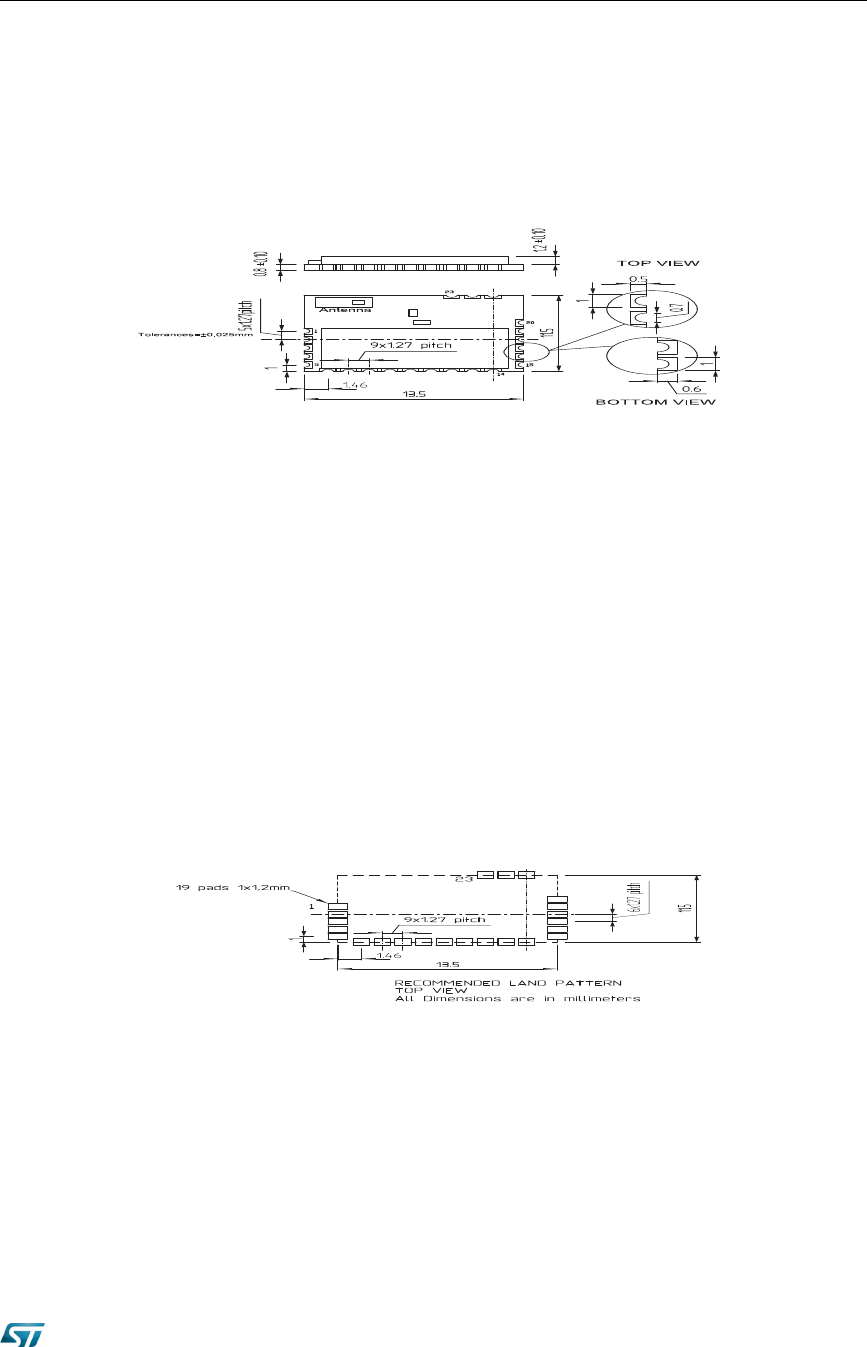
BlueNRG-M2SA
Rev 0.1 P a g e | 13 32
4.6 Mechanical dimensions
Figure 8: Mechanical dimensions
Figure 9: Recommend land pattern top view
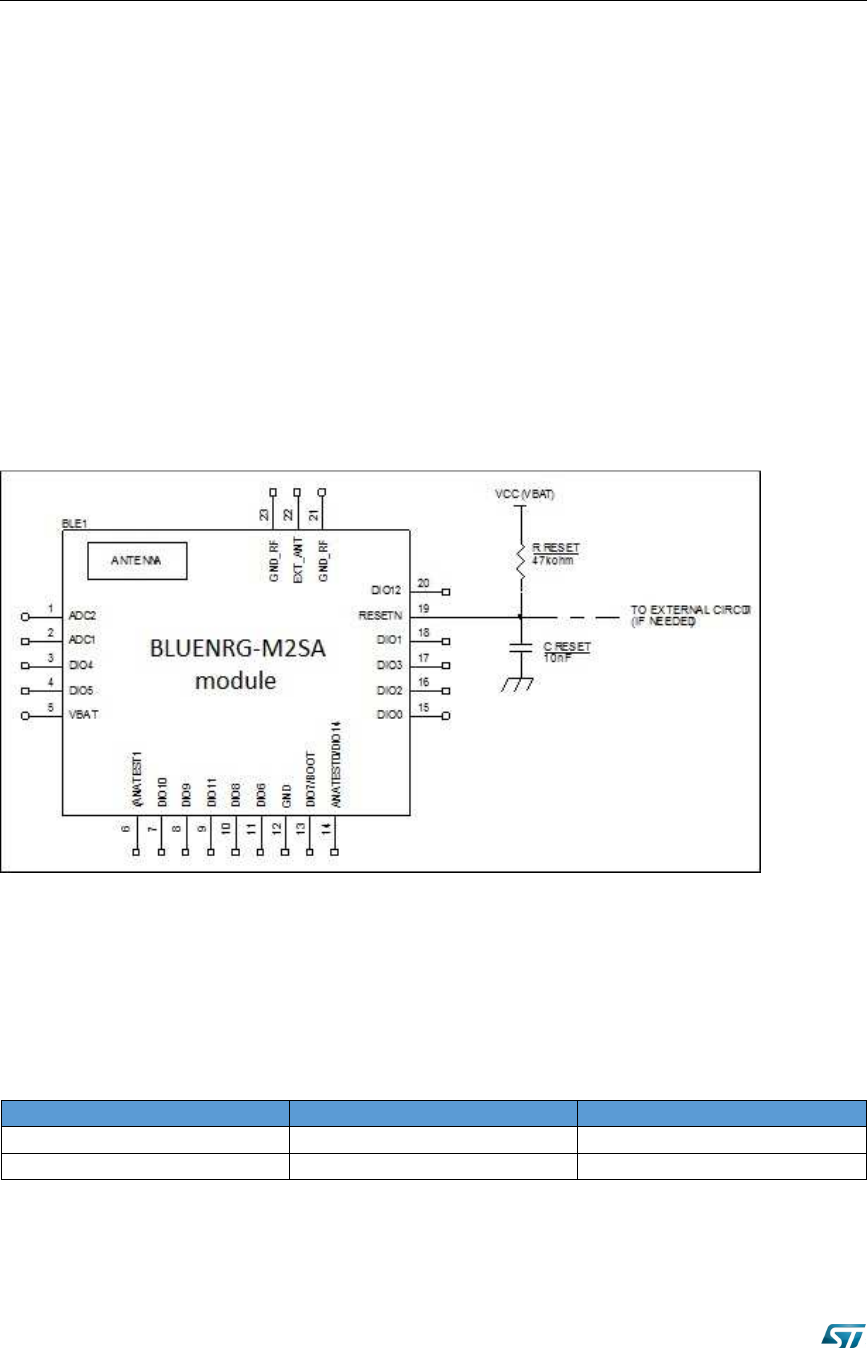
BlueNRG-M2SA
P a g e | 14 Rev. 0.1
5 Hardware design
Note:
-All unused pins should be left floating; do not ground.
-GND pin must be well grounded.
-Traces should not be routed underneath the module.
-The area around the module should be free of any ground planes, power planes,
trace routings, or metal for 6 mm from the module antenna position, in all directions.
5.1 Reset Circuitry
The BLUENRG-M2SA module requires an external pull-up reset circuitry to ensure proper operation at
power on. Refer to the “Reset management” chapter of the BlueNRG-2 datasheet for details.
Figure 10: Reset Circuitry
If reset pin is controlled by an external host, there is no need to have RC circuit on the RESETn line.
5.2 Debug Interface
The BLUENRG-M2SA embeds the ARM serial wire debug (SWD) port. It is two pins (clock and single bi-
directional data) debug interface, providing all the debug functionality plus real time access to system
memory without halting the processor or requiring any target resident code.
Pin Functionality Module PIN Pin description
SWCLK 12 SWD clock signal
SWDIO 13 SWD data signal
Table 6: Debug interface pin

BlueNRG-M2SA
Rev 0.1 P a g e | 15 32
For more information refer to the BlueNRG-2 technical documentation
(http://www.st.com/en/wireless-connectivity/BlueNRG-2.html )
5.3 Reflow soldering
The BLUENRG-M2SA is a high temperature strength surface mount Bluetooth® module
supplied on a 23 pin, 4-layer PCB.
Module is assembled with special soldering paste that allow to make the additional reflow
with no changes in the module original characteristic. It’s important to respect the parameter
listed in table 6.
The final assembly recommended reflow profiles are indicated here below.
Soldering phase has to be executed with care: in order to avoid undesired melting
phenomenon, particular attention has to be taken on the set up of the peak temperature.
Here following some suggestions for the temperature profile based on following
recommendations.
Table 6. Soldering
Profile feature
PB-free assembly
Average ramp up rate (TSMAX to Tp)
3°C/ sec max
Preheat
Temperature min (TS mn)
Temperature max (TS max)
Time (tS min to tS max) (tS)
150 °C
200 °C
60-100 sec
Time maintained above:
Temperature TL
Time tL 217 °C
60-70 sec
Peak temperature (TP)
240 + 0 °C
Time within 5 °C of actual peak temperature (TP)
10-20 sec
Ramp down rate
6 °C/sec
Time from 25 °C to peak temperature
8 minutes max
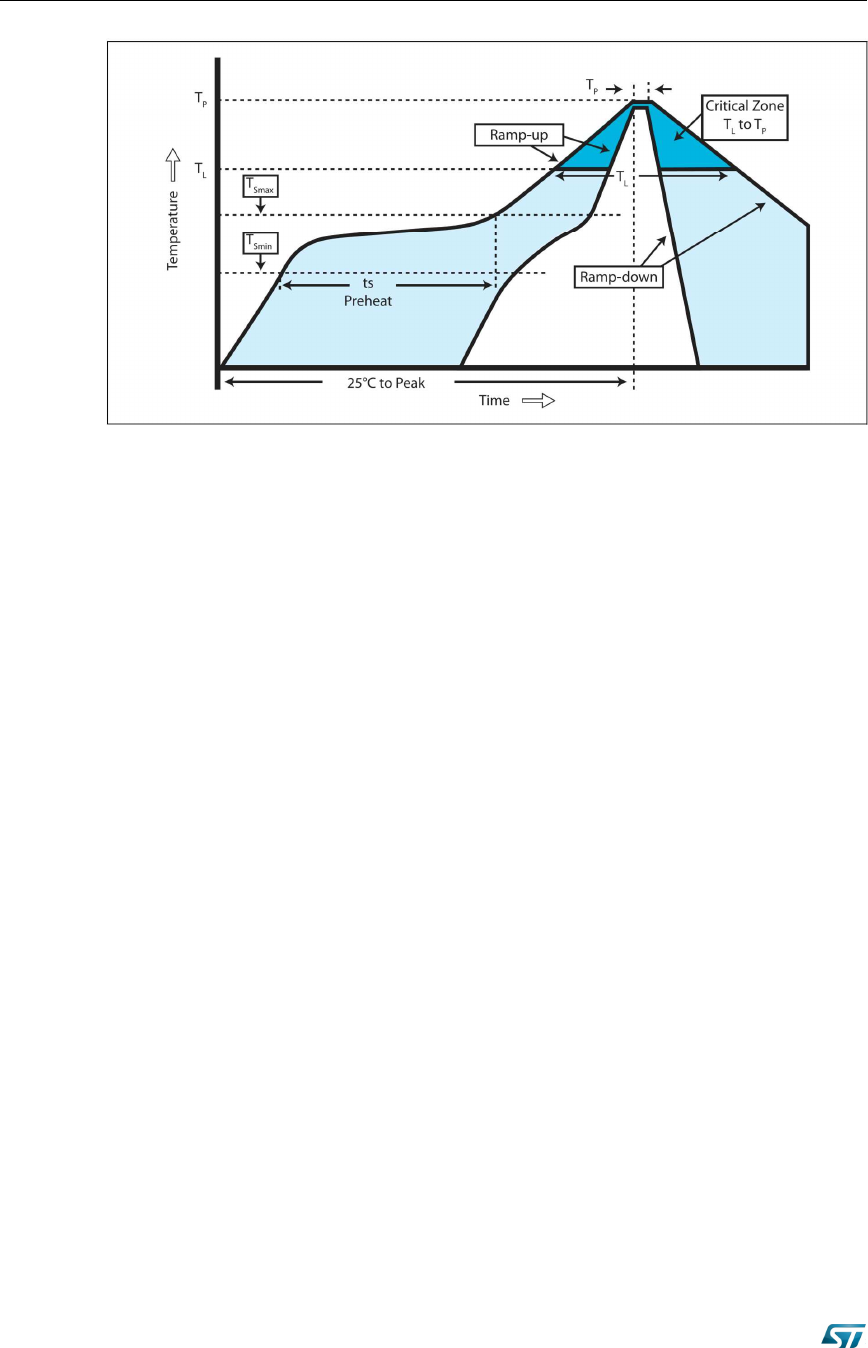
BlueNRG-M2SA
P a g e | 16 Rev. 0.1
Figure 11: Soldering profiles
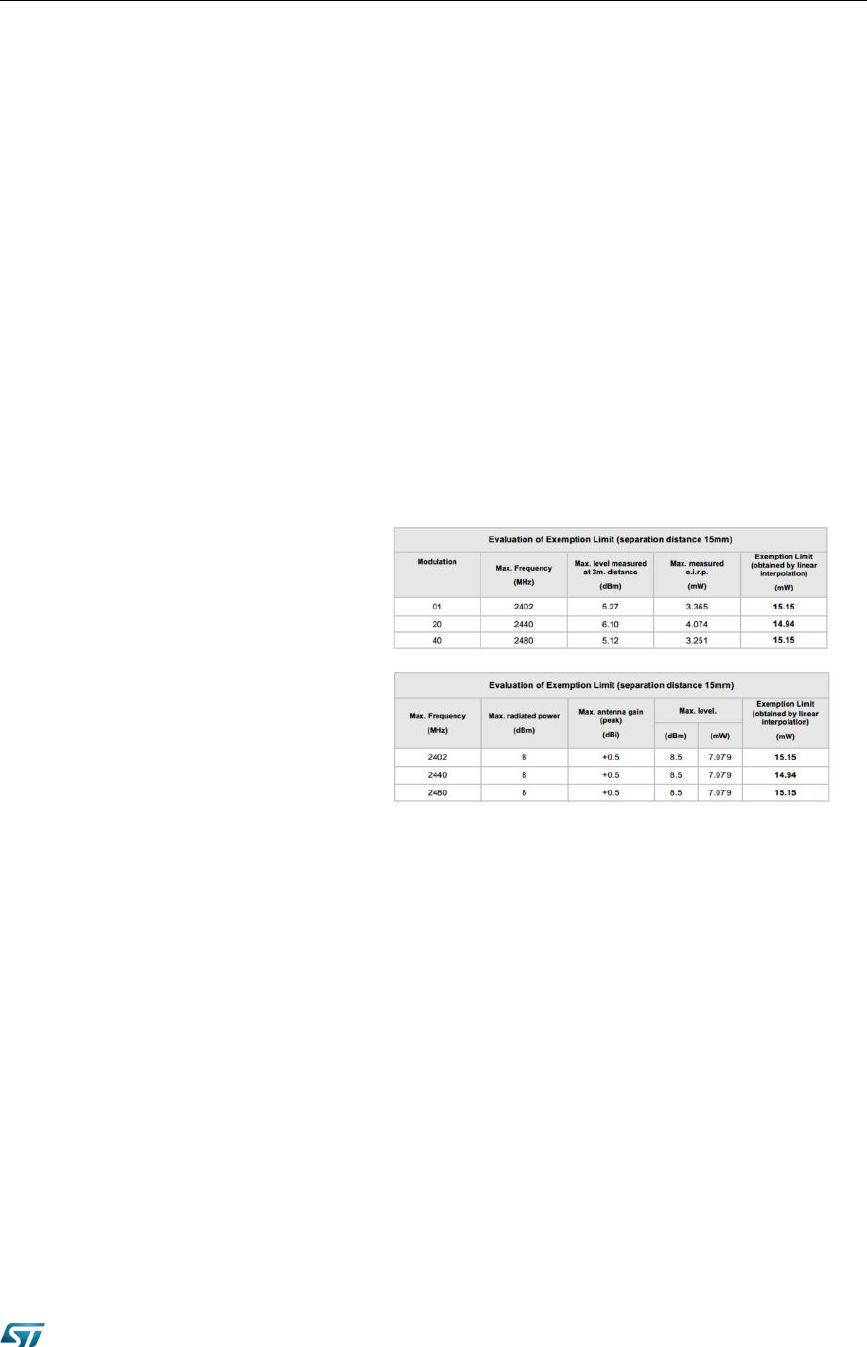
BlueNRG-M2SA
Rev 0.1 P a g e | 17 32
6
6.1
Regulatory compliance
FCC certification
This module has been tested and found to comply with the FCC part 15 rules. These limits
are designed to provide reasonable protection against harmful interference in approved
installations. This equipment generates, uses, and can radiate radio frequency energy and,
if not installed and used in accordance with the instructions, may cause harmful interference
to radio communications.
However, there is no guarantee that interference may not occur in a particular installation.
This device complies with part 15 of the FCC rules. Operation is subject to the following two
conditions:
1. This device may not cause harmful interference, and
2. this device must accept any interference received, including interference that may cause
undesired operation.
6.1.1
Modifications or changes to this equipment not expressly approved by STMicroelectronics
may render void the user's authority to operate this equipment.
In addition, the RF exposure compliance distance of the BLUENRG-M2SA is set equal to
15 mm, as shown in the following Tables.
Modular approval
FCC ID: S9NBNRGM2SA
In accordance with FCC part 15, the BLUENRG-M2SA is listed as a modular transmitter
device.
This module is evaluated for stand-alone use only. Finished products incorporating multiple
transmitters must comply with colocation and RF exposure requirements in accordance
with FCC multi-transmitter product procedures. Collocated transmitters operating in
portable RF Exposure conditions (e.g. <20 cm from persons including but not limited to
body worn and hand held devices) may require separate approval.
Labeling instructions
When integrating the BLUENRG-M2SA into the final product, the OEM must ensure that
the FCC labeling requirements are satisfied. A statement must be included on the exterior
of the final product which indicates the product includes a certified module. The label
should state the following (or similar wording that conveys the same meaning):
Contains FCC ID: S9NBNRGM2SA
OR
This product contains FCC ID: S9NBNRGM2SA
The OEM must include the following statements on the exterior of the final product unless
the product is too small (e.g. less than 4 x 4 inches):
This device complies with Part 15 of the FCC Rules. Operation is subject to the following
two conditions:

BlueNRG-M2SA
P a g e | 18 Rev. 0.1
1. this device may not cause harmful interference,
and
2. this device must accept any interference received,
including any interference that may cause
undesired operation.
6.1.2 Product manual instructions
This section applies to OEM final products containing the BLUENRG-M2SA module,
subject to FCC compliance. The final product manual must contain the following statement
(or a similar statement that conveys the same meaning):
Warning:
Changes or modifications not expressly approved by the
party responsible for compliance could void the user's
authority to operate the equipment. (Part. 15.21)
In the case where an OEM seeks Class B (residential) limits for the final product, the
following statement must be included in the final product manual:
Note: This equipment has been tested and found to comply with the limits for a Class B digital
device, pursuant to part 15 of the FCC Rules. These limits are designed to provide
reasonable protection against harmful interference in a residential installation. This
equipment generates, uses and can radiate radio frequency energy and, if not installed
and used in accordance with the instructions, may cause harmful interference to radio
communications. However, there is no guarantee that interference will not occur in a
particular installation. If this equipment does cause harmful interference to radio or
television reception, which can be determined by turning the equipment off and on, the
user is encouraged to try to correct the interference by one or more of the following
measures:
• Reorient or relocate the receiving antenna.
• Increase the separation between the equipment and receiver.
• Connect the equipment into an outlet on a circuit different from that to which the
receiver is connected.
• Consult the dealer or an experienced radio/TV technician for help.
In the case where an OEM seeks the lesser category of a Class A digital device for the
final product, the following statement must be included in the final product manual:
Note: This equipment has been tested and found to comply with the limits for a Class A digital
device, pursuant to part 15 of the FCC Rules. These limits are designed to provide
reasonable protection against harmful interference when the equipment is operated in a
commercial environment. This equipment generates, uses, and can radiate radio
frequency energy and, if not installed and used in accordance with the instruction manual,
may cause harmful interference to radio communications. Operation of this equipment in a
residential area is likely to cause harmful interference in which case the user will be
required to correct the interference at his expense.
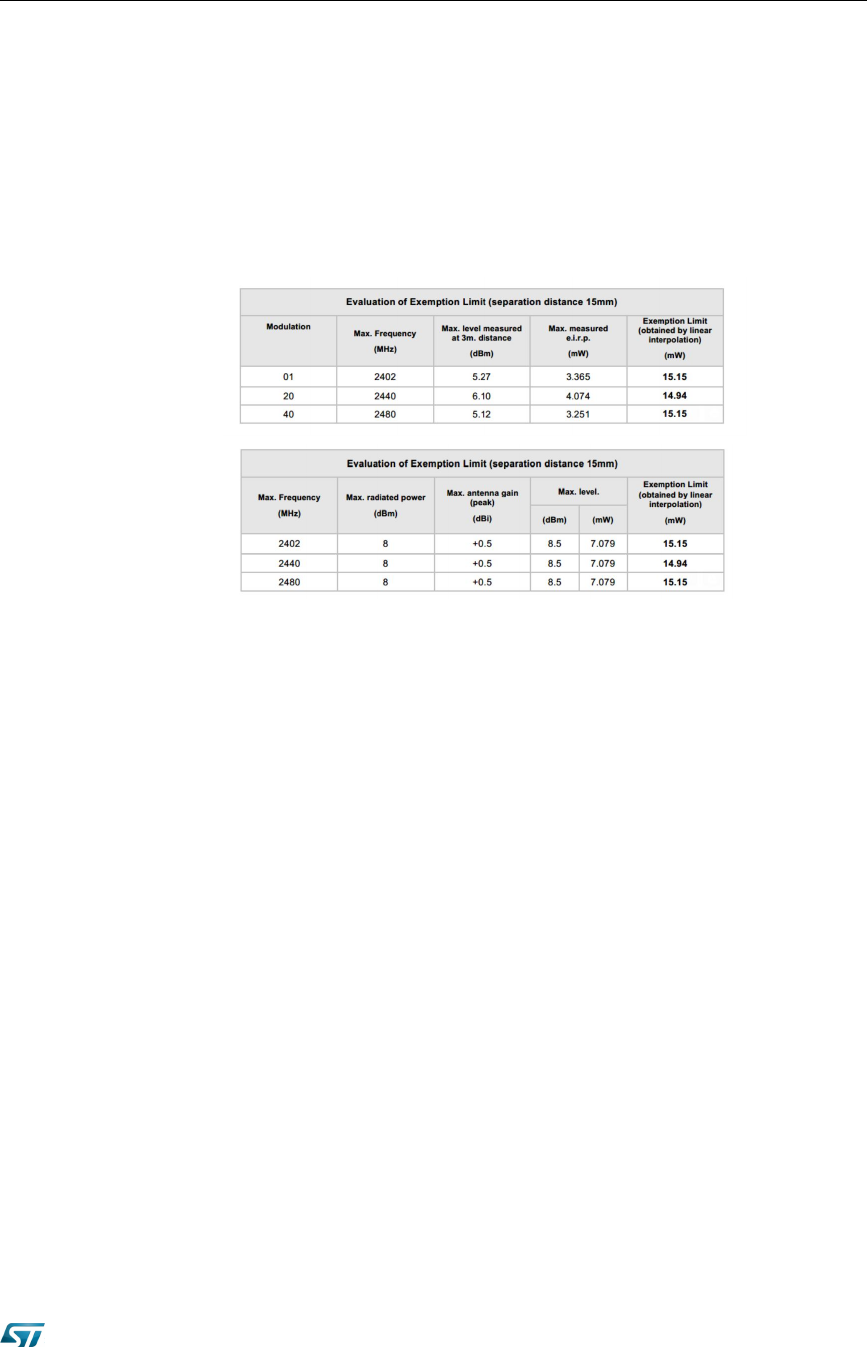
BlueNRG-M2SA
32 Rev 0.1 P a g e | 19
6.2
IC certification
This device contains licence-exempt transmitter(s)/receiver(s) that comply with Innovation,
Science and Economic Development Canada’s licence-exempt RSS(s). Operation is subject
to the following two conditions:
1. This device may not cause interference.
2. This device must accept any interference, including interference that may cause
undesired operation of the device.
6.2.1
Modular approval
IC: 8976C-BNRGM2SA
In accordance with IC RSS-247, the BLUENRG-M2SA is listed as a modular transmitter
device.
This module is evaluated for stand-alone use only. Finished products incorporating
multiple transmitters must comply with colocation and RF exposure requirements in
accordance with IC multi-transmitter product procedures. Collocated transmitters
operating in portable RF Exposure conditions (e.g. <20cm from persons including but not
limited to body worn and hand held devices) may require separate approval.
Labeling instructions
When integrating the BLUENRG-M2SA into the final product, the OEM must ensure that
the IC labeling requirements are satisfied. A statement must be included on the exterior of
the final product which indicates that the product includes a certified module. The label
should state the following (or similar wording that conveys the same meaning):
Contains IC: 8976C-BNRGM2SA
OR
This product contains IC: 8976C-BNRGM2SA
The OEM must include the following statements on the exterior of the final product unless
the product is too small (e.g. less than 4 x 4 inches):
This device complies with RSS-247 of the IC Rules. Operation is subject to the following
two conditions:
1. this device may not cause harmful interference, and
In addition, accordingly to RSS-102 clause 2.6, the RF exposure compliance distance
of the BLUENRG-M2SA is set equal to 15 mm, as shown in the following Tables.

BlueNRG-M2SA
P a g e | 20 Rev. 0.1
2. this device must accept any interference received,
including any interference that may cause
undesired operation.
6.2.2 Product manual instructions
This section applies to OEM final products containing the BLUENRG-M2SA module, subject
to IC compliance. The final product manual must contain the following statement (or a
similar statement that conveys the same meaning):
Warning: Changes or modifications not expressly approved by the
party responsible for compliance could void the user's
authority to operate the equipment. (RSS-247)
Note:
In the case where an OEM seeks Class B (residential) limits for the final product, the
following statement must be included in the final product manual:
This equipment has been tested and found to comply with the limits for a Class B digital
device, pursuant to RSS-247 of the IC Rules. These limits are designed to provide
reasonable protection against harmful interference in a residential installation. This
equipment generates, uses and can radiate radio frequency energy and, if not installed
and used in accordance with the instructions, may cause harmful interference to radio
communications. However, there is no guarantee that interference will not occur in a
particular installation. If this equipment does cause harmful interference to radio or
television reception, which can be determined by turning the equipment off and on, the
user is encouraged to try to correct the interference by one or more of the following
measures:
• Reorient or relocate the receiving antenna.
• Increase the separation between the equipment and receiver.
• Connect the equipment into an outlet on a circuit different from that to which the
receiver is connected.
• Consult the dealer or an experienced radio/TV technician for help.
Note:
In the case where an OEM seeks the lesser category of a Class A digital device for the
final product, the following statement must be included in the final product manual:
This equipment has been tested and found to comply with the limits for a Class A digital
device, pursuant to RSS-247 of the IC Rules. These limits are designed to provide
reasonable protection against harmful interference when the equipment is operated in a
commercial environment. This equipment generates, uses, and can radiate radio
frequency energy and, if not installed and used in accordance with the instruction manual,
may cause harmful interference to radio communications. Operation of this equipment in a
residential area is likely to cause harmful interference in which case the user will be
required to correct the interference at his expense.

BlueNRG-M2SA
32
Rev 0.1 P a g e | 21
6.3 EU Type approval for BLUENRG-M2SA module
The BLUENRG-M2SA module has been certified in conformity with the essential
requirements of the RED Directive (Radio Equipment Directive) 20174/53/EU based on the
tests done according to the following standards:
• ETSI EN 300 328 V2.1.1 (2016:11)
ETSI EN 301 489-17 V3.1.1 (2017-02)
•
ETSI EN 301 489-1 V2.1.1 (2017-02)
• EN 60950-1:2006 + A11:2009 + A12:2011 + A1:2010 + A2:2013 + AC:2011
• ETSI EN 300 328 V2.1.1 (2016-11)
• EN62479:2010
The module is provided by CE marking:
For additional information please refer to:
STMicroelectronics Via C. Olivetti , 2 Agrate Brianza 20864 (ITALY)
The BLUENRG-M2SA module current production firmware release is: SDK3.0.0
6.4 Bluetooth certification
The module with embedded stack and profile has been qualified in accordance with SIG
qualification rules:
• Declaration ID:
D034470
• Qualified design ID: 92838
• Product type: End Product
• Core spec version: 5.0
• Product description: Bluetooth Smart v5.0 module
(Please see APPENDIX A for the French translation)
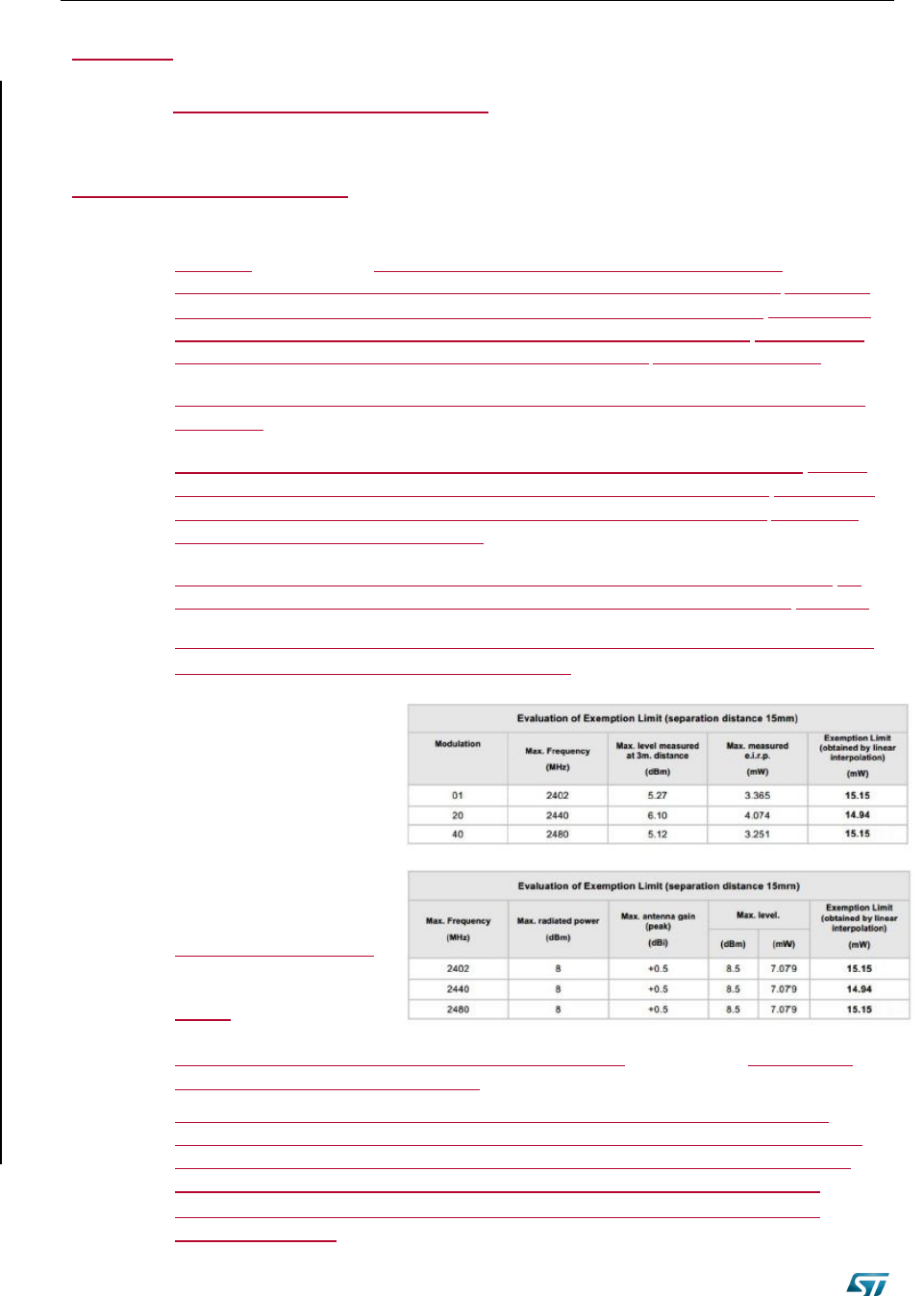
BlueNRG-M2SA
P a g e | 22 Rev. 0.1
Appendix A
Déclaration de conformité
A.1 Certification FCC
Le module BLUENRG-M2SA a été testé et déclaré conforme avec la section 15 de la
Règlementation FCC. Ces limitations sont stipulées afin de procurer une protection raisonnable
contre les interférences gênantes dans les installations approuvées. Cet appareil génère, utilise
et diffuse des ondes radio et, s’il n’est pas installé et utilisé en conformité avec les instructions
dont il fait l’objet, peut causer des interférences gênantes sur les communications radio.
Il n’y a cependant pas de garantie qu’une interférence ne se produira pas dans une installation
particulière.
Cet appareil est en conformité avec la section 15 des règlements FCC. L’utilisation est soumise
aux deux conditions suivantes: (1) cet appareil ne doit pas causer d'interférences nocives, et (2)
Cet appareil doit supporter toute interférence reçue, y compris des interférences qui peuvent
provoquer un fonctionnement non désiré.
Tout changement ou modification fait(e) à cet appareil et non expressément approuvé(e) par
STMicroelectronics peut annuler l’autorisation pour l’utilisateur de faire fonctionner l’appareil.
En outre, la distance de conformité d'exposition RF du BLUENRG-M2SA est fixée à 15
mm, comme indiqué dans les tableaux suivants.
Approbation du module
FCC ID: S9NBNRGM2SA
Conformément à la section 15 des règlements FCC, le module BLUENRG-M2SA est répertorié
comme un dispositif émetteur modulaire.
Ce module n’est évalué que pour une utilisation autonome. Les produits finis incorporant
plusieurs émetteurs doivent être conformes à la colocation et aux exigences d'exposition RF
en concordance avec les procédures FCC multi-émetteurs. D’autres émetteurs fonctionnant
dans des dispositifs portables exposés aux RF (par exemple, situés à moins de 20 cm des
personnes avec dispositifs portatifs ou portés contre le corps) peuvent nécessiter d'une
approbation séparée.

BlueNRG-M2SA
32 Rev 0.1 P a g e | 23
A.1.1 Instructions d'étiquetage
Lors de l'intégration du module BLUENRG-M2SA dans le produit final, le fabricant doit
s’assurer que les exigences en matière d'étiquetage de la FCC sont satisfaites. Une déclaration
doit être placée sur l’étiquette extérieure du produit final indiquant que le produit comprend
un module certifié. L'étiquette doit comporter les informations suivantes (ou une mention
analogue que recouvre la même notion):
Contient FCC ID: S9NBNRGM2SA
OU Ce produit contient FCC ID: S9NBNRGM2SA
Le sous-traitant doit inclure les énoncés suivants sur l’étiquette extérieure du produit final à
moins que le produit ne soit trop petit (par exemple moins de 4 x 4 pouces):
Cet appareil est en conformité avec la section 15 des règlements FCC. L’utilisation est
soumise aux deux conditions suivantes:
(1) cet appareil ne doit pas causer d'interférences nocives, et
(2) Cet appareil doit supporter toute interférence reçue, y compris des interférences qui peuvent provoquer un
fonctionnement non désiré.
A.1.2 Instructions pour l’utilisation du produit
La présente section concerne les produits finis contenant le module BLUENRG-M2SA,
assujettis aux normes FCC. Le manuel du produit final doit contenir la déclaration suivante
(ou une mention analogue que recouvre la même notion):
“ Avertissement: Les changements ou modifications non expressément approuvés par la
partie responsable de la conformité pourraient annuler l'autorisation de l'utilisateur de faire
fonctionner cet équipement. (Section 15.21)”
Dans le cas où le produit finis d’un fabriquant OEM rentre dans les limites de la Classe B
(résidentiel), les énoncés suivants doivent être inclus dans le manuel du produit finis:

BlueNRG-M2SA
P a g e | 24 Rev. 0.1
“Remarque : Cet équipement a été testé et déclaré conforme aux limitations prévues dans le
cadre de la classe B des appareils numériques, définies par la section 15 du règlement de la
FCC. Ces limites sont conçues pour fournir une protection raisonnable contre toute
interférence dangereuse issue d'une installation résidentielle. Cet équipement produit, utilise
et peut émettre de l'énergie radio électrique et, s'il n'est pas installé et utilisé conformément
aux présentes instructions, peut causer des interférences nuisibles aux communications radio.
Cependant, il se peut que des interférences se produisent dans une installation particulière. Si
cet appareil cause des interférences nuisibles à la réception des signaux de radio ou de
télévision, ce qui peut être déterminé en allumant et en éteignant l'appareil, on encourage
l'utilisateur d'essayer de corriger ces interférences par l'un des moyens suivants:
– Réorienter ou repositionner l'antenne de réception.
– Augmenter la distance séparant l’équipement du récepteur.
– Connecter l’équipement à une prise appartenant à un circuit différent de celui sur
lequel le récepteur est connecté.
– Consulter le revendeur ou un technicien radio/TV expérimenté pour obtenir de l’aide.”
Dans le cas où le produit fini d’un sous-traitant rentre dans les limites imposées aux
appareils numériques de classe A, les énoncés suivants doivent être inclus dans le
manuel du produit finis:
“REMARQUE : Cet appareil a été testé et certifié conforme aux spécifications d'un appareil
électronique de classe A (class A digital device), conformément à la partie 15 du règlement de
la FCC. Ces contraintes sont destinées à fournir une protection raisonnable contre les
interférences nuisibles quand l'appareil est utilisé dans une installation commerciale. Cet
équipement produit, utilise et peut émettre de l'énergie radio électrique et, s'il n'est pas
installé et utilisé conformément aux présentes instructions, peut causer des interférences
nuisibles aux communications radio. L'utilisation de cet appareil dans une installation
résidentielle peut entraîner des interférences nuisibles et l'utilisateur devra corriger les
interférences à ses propres frais.”
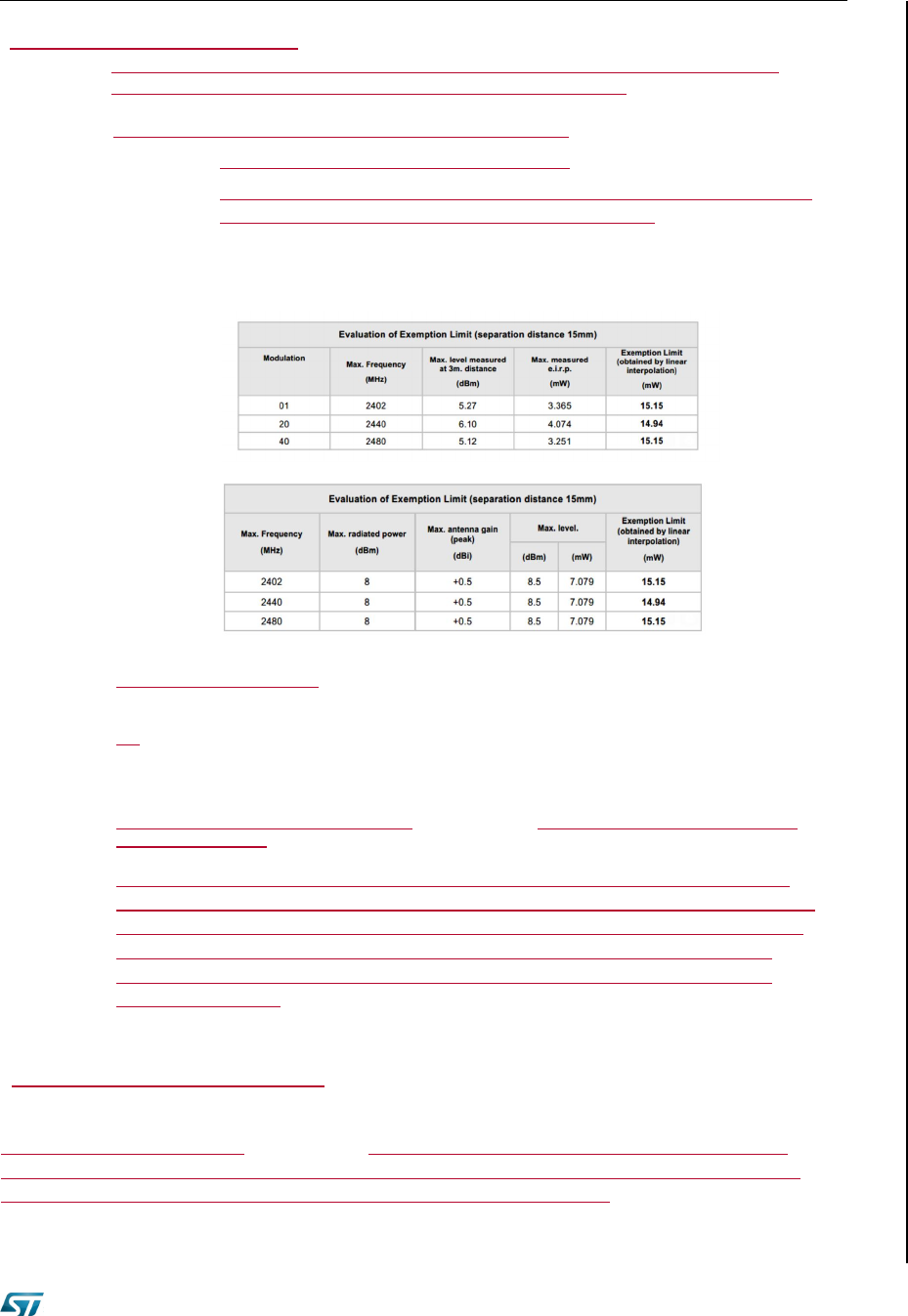
BlueNRG-M2SA
32 Rev 0.1 P a g e | 25
A.2
Certification IC
(a)
Cet appareil contient des émetteurs / récepteurs exemptés de licence conformes aux CNR
(CNR) d'Innovation, Sciences et Développement économique Canada.
Le fonctionnement est soumis aux deux conditions suivantes:
1. Cet appareil ne doit pas causer d'interférences.
2. Cet appareil doit accepter toutes les interférences, y compris celles susceptibles
de provoquer un fonctionnement indésirable de l'appareil.
Approbation du module
IC: 8976C-BNRGM2SA
Conformément à IC CNR-247, le module BLUENRG-M2SA est répertorié comme un dispositif
émetteur modulaire
Ce module n’est évalué que pour une utilisation autonome. Les produits finis incorporant
plusieurs émetteurs doivent être conformes à la colocation et aux exigences d'exposition RF
en concordance avec les procédures FCC multi-émetteurs. D’autres émetteurs fonctionnant
dans des dispositifs portables exposés aux RF (par exemple, situés à moins de 20 cm des
personnes avec dispositifs portatifs ou portés contre le corps) peuvent nécessiter d'une
approbation séparée.
A.2.1 Instructions d'étiquetage
Lors de l'intégration du module BLUENRG-M2SA dans le produit final, le fabricant doit s’assurer que les
exigences en matière d'étiquetage de la IC sont satisfaites. Une déclaration doit être placée sur l’étiquette
extérieure du produit final indiquant que le produit comprend un module certifié.
En outre, conformément à la clause 2.6 de la norme RSS-102, la distance de
conformité d'exposition RF du BLUENRG-M2SA est fixée à 15 mm, comme indiqué
dans les tableaux suivants.

BlueNRG-M2SA
P a g e | 26 Rev. 0.1
L'étiquette doit comporter les informations suivantes (ou une mention analogue que recouvre
la même notion):
Contient IC ID: 8976C-BNRGM2SA
OU Ce produit contient IC ID: 8976C-BNRGM2SA
Le sous-traitant doit inclure les énoncés suivants sur l’étiquette extérieure du produit final à
moins que le produit ne soit trop petit (par exemple moins de 4 x 4 pouces):
Cet appareil est en conformité aux normes IC. L’utilisation est soumise aux deux conditions
suivantes:
(1) cet appareil ne doit pas causer d'interférences nocives, et
(2) Cet appareil doit supporter toute interférence reçue, y compris des interférences qui
peuvent provoquer un fonctionnement non désiré
A.2.2 Instructions pour l’utilisation du produit
La présente section concerne les produits finis contenant le module BLUENRG-M2SA, assujettis
aux normes IC. Le manuel du produit final doit contenir la déclaration suivante (ou une mention
analogue que recouvre la même notion):
“Avertissement: Les changements ou modifications non expressément approuvés par la
partie responsable de la conformité pourraient annuler l'autorisation de l'utilisateur de faire
fonctionner cet équipement. (CNR-247)”
Dans le cas où le produit finis d’un fabriquant OEM rentre dans les limites de la Classe B
(résidentiel), les énoncés suivants doivent être inclus dans le manuel du produit finis:
“ Remarque : Cet équipement a été testé et déclaré conforme aux limitations prévues dans le
cadre de la classe B des appareils numériques, définies par la norme CNR-247 d'Industrie
Canada.

BlueNRG-M2SA
32 Rev 0.1 P a g e | 27
Ces limites sont conçues pour fournir une protection raisonnable contre toute interférence
dangereuse issue d'une installation résidentielle. Cet équipement produit, utilise et peut
émettre de l'énergie radio électrique et, s'il n'est pas installé et utilisé conformément aux
présentes instructions, peut causer des interférences nuisibles aux communications radio.
Cependant, il se peut que des interférences se produisent dans une installation particulière. Si
cet appareil cause des interférences nuisibles à la réception des signaux de radio ou de
télévision, ce qui peut être déterminé en allumant et en éteignant l'appareil, nous
encourageons l'utilisateur à essayer de corriger ces interférences par l'un des moyens suivants:
– Réorienter ou repositionner l'antenne de réception.
– Augmenter la distance séparant l’équipement du récepteur.
– Connecter l’équipement à une prise appartenant à un circuit différent de celui sur
lequel le récepteur est connecté.
– Consulter le revendeur ou un technicien radio/TV expérimenté pour obtenir de l’aide.”
Dans le cas où le produit finis d’un fabriquant OEM rentre dans le cadre des limites imposées
aux appareils numériques de classe A, les énoncés suivants doivent être inclus dans le manuel
du produit finis:
“ REMARQUE: Cet appareil a été testé et certifié conforme aux spécifications d'un appareil
électronique de classe A (class A digital device), conformément à la norme CNR-247 d'Industrie
Canada. Ces contraintes sont destinées à fournir une protection raisonnable contre les
interférences nuisibles quand l'appareil est utilisé dans une installation commerciale. Cet
équipement produit, utilise et peut émettre de l'énergie radio électrique et, s'il n'est pas
installé et utilisé conformément aux présentes instructions, peut causer des interférences
nuisibles aux communications radio. L'utilisation de cet appareil dans une installation
résidentielle peut entraîner des interférences nuisibles et l'utilisateur devra corriger les
interférences à ses propres frais.”
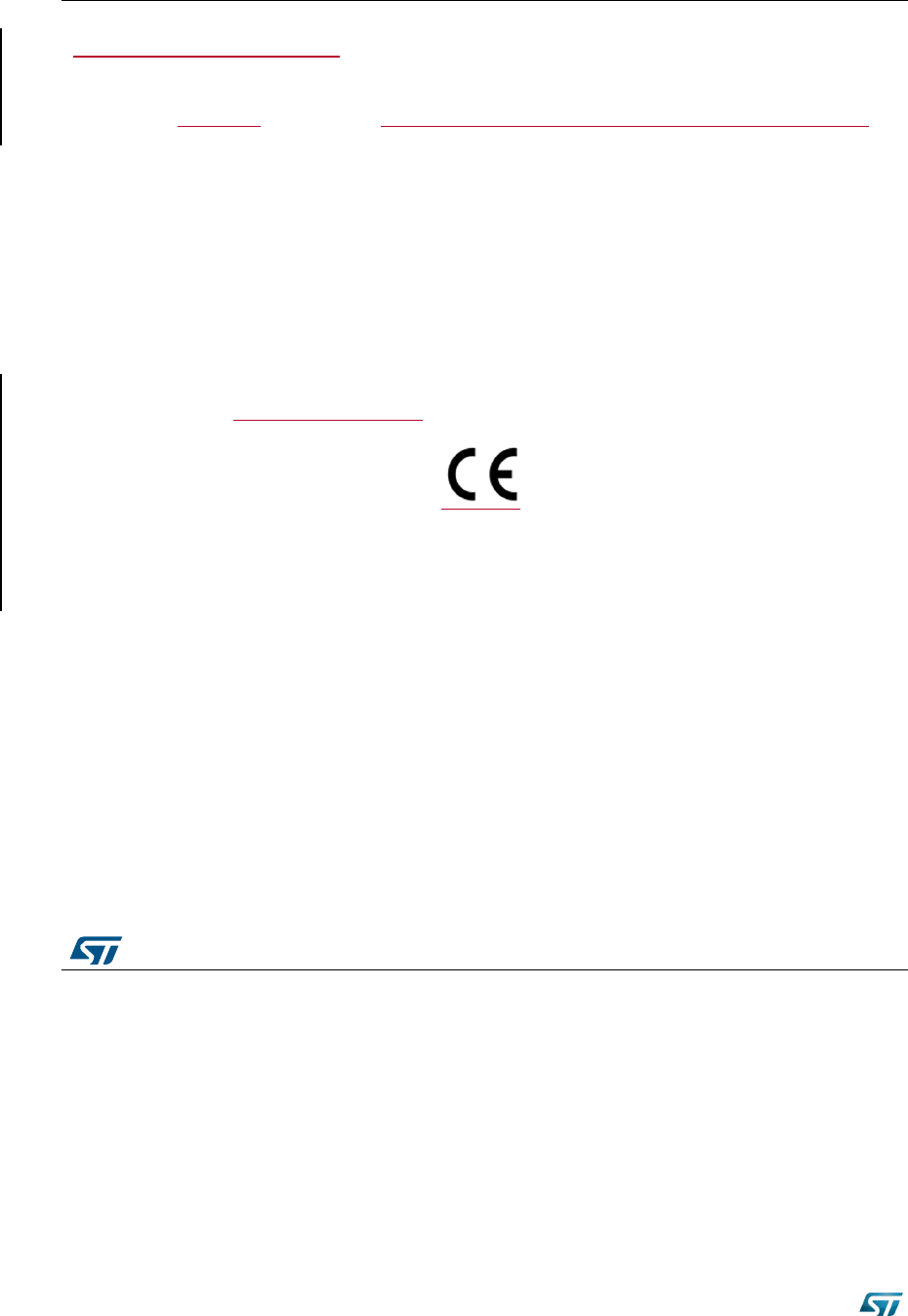
BlueNRG-M2SA
P a g e | 28
Rev. 0.1
A.3 Certification CE
Le module BLUENRG-M2SA a obtenu une certification de conformité aux normes suivantes:-
-
EN 62479:2010
-
EN 60950-1:2006 + A11:2009 + A1:2010 + A12:2011 + A2:2013
-
ETSI EN 301 489-17 V3.1.1 (2017-02)
-
ETSI EN 301 489-1 V2.1.1 (2017-02)
-
ETSI EN 300 328 v 2.1.1 (2016-11)
Le module est certifié CE:

SPBTLE-1SS
32
Rev 0.1 P a g e | 29
7 Ordering information
Order code
Description
Packing
MOQ
BlueNRG-M2SA
Bluetooth
®
V5.0 module
TBD
TBD
Figure 12: Ordering information
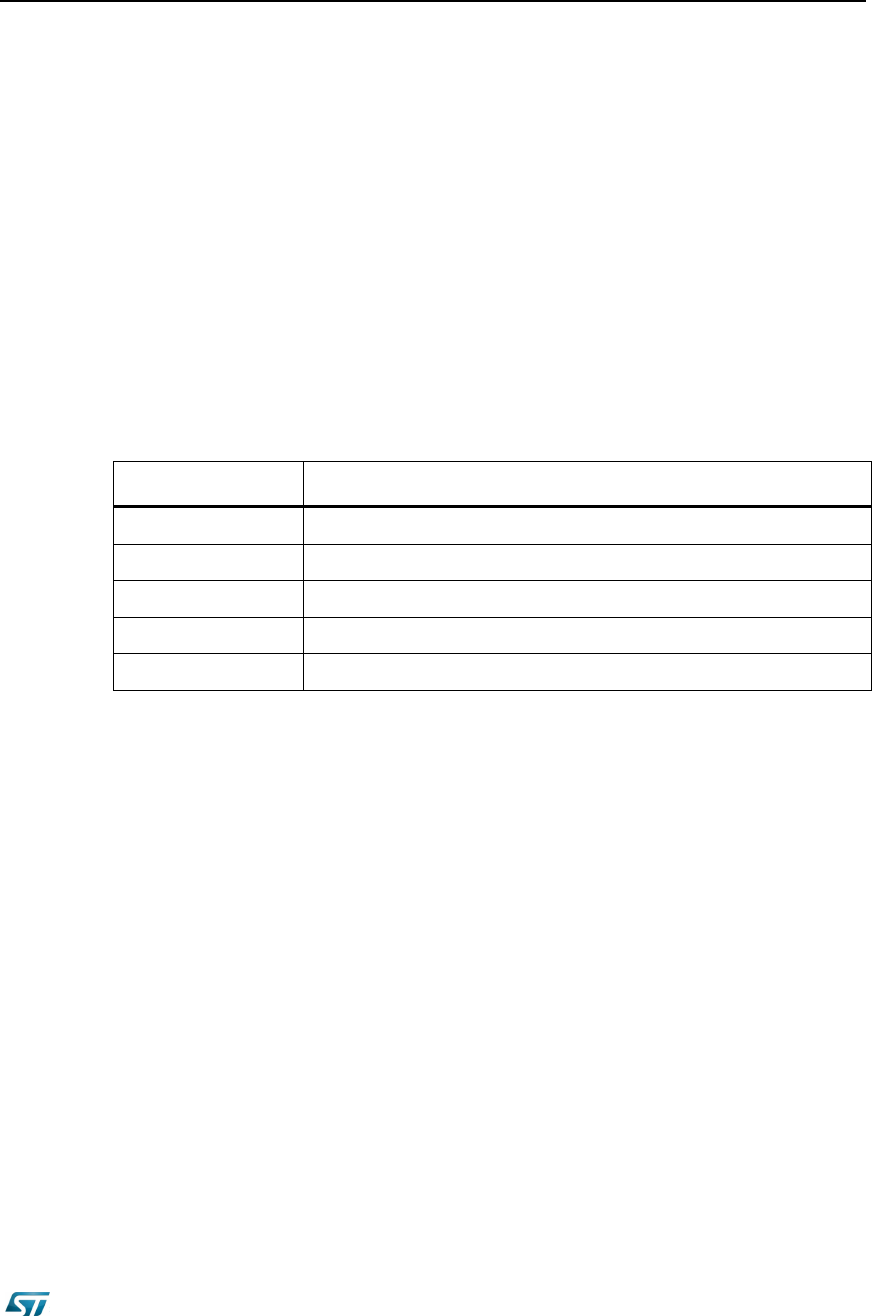
BlueNRG-M2SA
32
Rev 0.1 P a g e | 30
8 ECOPACK
®
In order to meet environmental requirements, ST offers these devices in different grades of
ECOPACK
®
packages, depending on their level of environmental compliance. ECOPACK
®
specifications, grade definitions and product status are available at: www.st.com.
ECOPACK
®
is an ST trademark.
9 Traceability
Each module is univocally identified by serial number stored in a 2D data matrix laser
marked on the bottom side of the module itself.
The serial number has the following format:
Letter
Meaning
WW
Week
YY
Year
D
Product ID family
FF
Production panel coordinate identification
NNN
Progressive serial number.
Figure 13: Traceability information
Each module bulk is identified by a bulk ID.
BULK ID and module 2D data matrix are linked by a reciprocal traceability link.
The module 2D data matrix traces the lot number of any raw material used.

BlueNRG-M2SA
Rev 0.1 P a g e | 31
32
10 Revision history
Date
Revision
Changes
October 19, 2018
1
Initial release.
Figure 14: Document revision history

BlueNRG-M2SA
P a g e | 32
Rev. 0.1
IMPORTANT NOTICE – PLEASE READ CAREFULLY
STMicroelectronics NV and its subsidiaries (“ST”) reserve the right to make changes, corrections, enhancements, modifications, and
improvements to ST products and/or to this document at any time without notice. Purchasers should obtain the latest relevant information
on ST products before placing orders. ST products are sold pursuant to ST’s terms and conditions of sale in place at the time of order
acknowledgement.
Purchasers are solely responsible for the choice, selection, and use of ST products and ST assumes no liability for application assistance or
the design of Purchasers’ products.
No license, express or implied, to any intellectual property right is granted by ST herein.
Resale of ST products with provisions different from the information set forth herein shall void any warranty granted by ST for such product.
ST and the ST logo are trademarks of ST. All other product or service names are the property of their respective owners.
Information in this document supersedes and replaces information previously supplied in any prior versions of this document.
© 2016 STMicroelectronics – All rights reserved